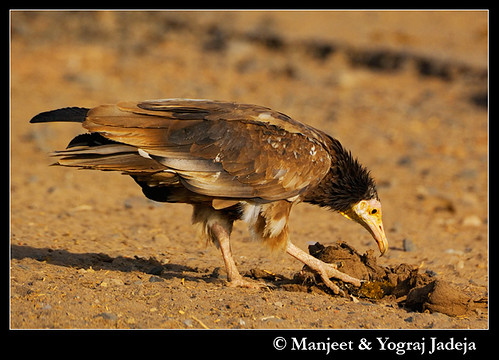We have updated Our Photo Gallery, do check it out.
Saturday, December 11, 2010
Friday, December 3, 2010
Did you know? Beak facts
Most waders have different lengths of beaks, so that even when they all feed together each species feeds at different depths. most waders have nostrils at the base of the beak and the tip of the beak is extra sensitive, to feel the prey underground.
The kiwi bird is unique in that it has nostrils at the tip of the beak, making it extremely sensitive to smell.
News,Reviews,Tips,wildlife,nature, photography
bird,
birds,
Did you know?
Monday, October 18, 2010
Published in BBC Wildlife magazine (oct '10)
Just got one of our images published in BBC Wildlife Magazine (oct '10)
on page 111

Nikon D40 with Sigma 170-500mm DG Manual focus
on page 111

Nikon D40 with Sigma 170-500mm DG Manual focus
Saturday, October 16, 2010
Sneak preview of Veolia Environnement Wildlife Photographer of the Year
The world’s most prestigious wildlife photography competition,
Veolia Environnement Wildlife Photographer of the Year,
has revealed the commended images from this year’s competition.
Have a Sneak preview
Veolia Environnement Wildlife Photographer of the Year,
has revealed the commended images from this year’s competition.
Have a Sneak preview
Friday, October 8, 2010
Did you Know? - Crab Plovers
The crab plover (Dromas ardeola) is the only member of
the Dromadidae family,
and has no close living relatives.
It is also unique among waders,
in using ground warmth to aid incubation of eggs.
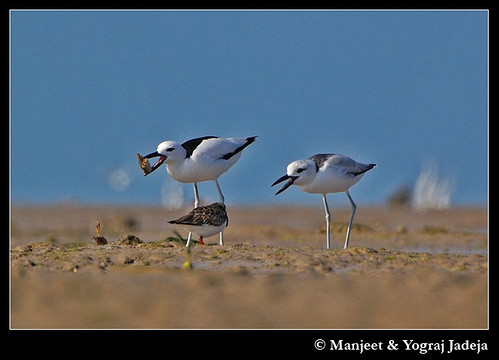
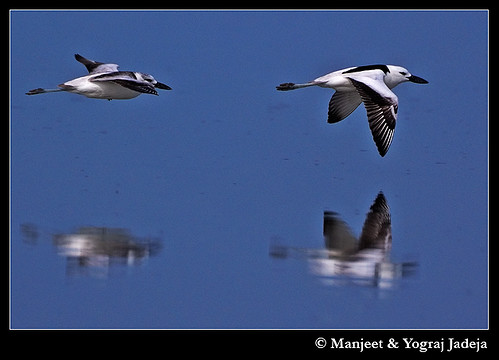
News,Reviews,Tips,wildlife,nature, photography
animal,
Did you know?,
fact,
facts,
wildlife
Thursday, September 30, 2010
Our Images Published in a book about Nature Education
We feel fortunate to have our photographs (5 images inside and back cover image) featured in "Glimpses from India's natural world"
A book for nature education - By Shri AK Sahay.
The book has been Edited by Shri JC Daniel and Foreword by George B Schallar
It is an excellent book with beautiful images and thought provoking text.
sharing a few pages, with permission of shri Sahay
cover (Image - Shri Vivek Sinha)

Back cover
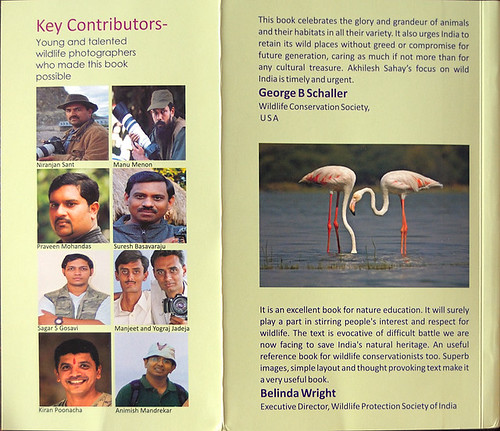
View the images published in the book here and
All our published images here
To know more about where our images have appeared click here
A book for nature education - By Shri AK Sahay.
The book has been Edited by Shri JC Daniel and Foreword by George B Schallar
It is an excellent book with beautiful images and thought provoking text.
sharing a few pages, with permission of shri Sahay
cover (Image - Shri Vivek Sinha)

Back cover

View the images published in the book here and
All our published images here
To know more about where our images have appeared click here
News,Reviews,Tips,wildlife,nature, photography
book,
publication,
published
Saturday, September 25, 2010
Did you know? - Little Grebe


The little grebe (Tachybaptus ruficollis), also known as the Dabchick,
is the smallest member of the grebe family.
is the smallest member of the grebe family.
All grebes are accomplished divers and to assist them in swimming under water
the bird’s lobed feet are placed well back at the rear of their bodies.
In fact, a grebe cannot move well on land and rarely comes ashore,
mostly to breed.
News,Reviews,Tips,wildlife,nature, photography
animal,
Did you know?,
fact,
facts,
wildlife
Wednesday, September 15, 2010
Beauty of Grasslands
Forget about species extinction, Homo sapiens are responsible for destroying
huge chunks of entire ecosystems.
surely we need to be wiser, if we want to survive on this planet.
we have been like parasites and its high time we develop a symbiotic relationship
with our planet instead of spending billions on searching other planets for life.
We have already lost 50% of our Grassland Habitats
and continue to do so even today.
The beauty of Grassland is just breathtaking,
and supports a lot of endangered species.
here we share some of our favourite grassland images.
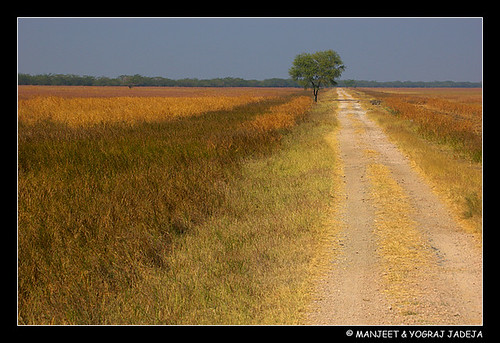

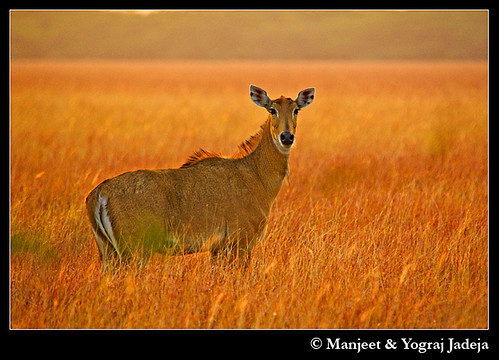





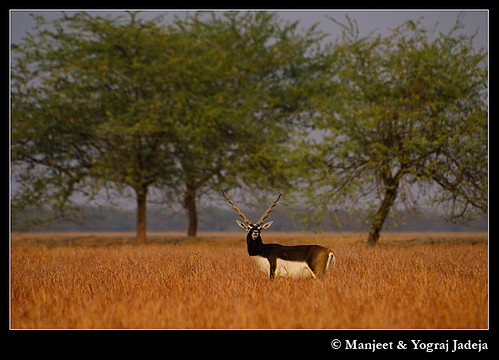

huge chunks of entire ecosystems.
surely we need to be wiser, if we want to survive on this planet.
we have been like parasites and its high time we develop a symbiotic relationship
with our planet instead of spending billions on searching other planets for life.
We have already lost 50% of our Grassland Habitats
and continue to do so even today.
The beauty of Grassland is just breathtaking,
and supports a lot of endangered species.
here we share some of our favourite grassland images.










eia report about illegal wildlife trade
eia Report about illegal wildlife trade (tiger and leopard skins and parts)
Monday, September 6, 2010
Peregrine Preening
On our last trip to the Little rann of kutch,
we had missed the opportunity to see
this beautiful raptor, as our car had got stuck
in the wet desert mud.
This time we kept our distance from the lake
to avoid getting stuck.
This time we got lucky. Raptors (like most birds)
spend a considerable time preening their feathers,
we spent almost 90 minutes watching the Peregrine Falcon
scratching and preening its feathers, before taking off.





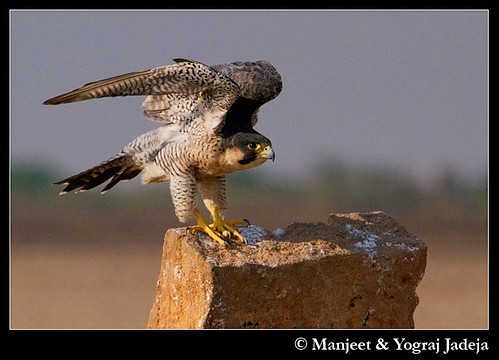


we had missed the opportunity to see
this beautiful raptor, as our car had got stuck
in the wet desert mud.
This time we kept our distance from the lake
to avoid getting stuck.
This time we got lucky. Raptors (like most birds)
spend a considerable time preening their feathers,
we spent almost 90 minutes watching the Peregrine Falcon
scratching and preening its feathers, before taking off.








Thursday, September 2, 2010
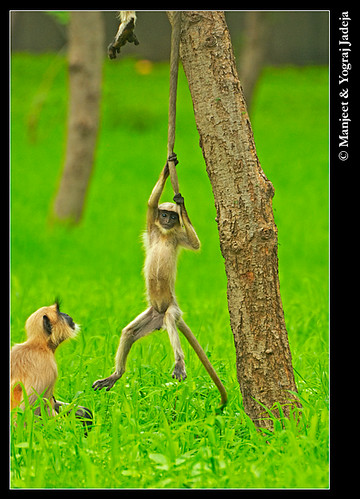
We have photographed the Hanuman langur before,
But never seemed to like any of the shots.
On this particular day the light was softened by the clouds
and the juveniles were in a playful mood.
The only problem was the low light and
to add to that the playful mood of the juveniles,
who were always on the move.
Shooting lots of frames was the only way to get a few usable frames.
It is one of our all time favorites, as we feel that it captures
the playful character of the Langurs
It is one of our all time favorites, as we feel that it captures
the playful character of the Langurs
Wednesday, September 1, 2010
Ethics in wildlife Photography
(An interesting article in BBC Wildlife magazine)
http://bit.ly/aaGJSf
(An interesting article in BBC Wildlife magazine)
http://bit.ly/aaGJSf
Recently published
We feel fortunate to have the following images published in
"Glimpses From India's Natural World"
a book about conservation by Shri Akhilesh Sahay who also Authored
"Green Tops in Goa".
We are sure that "Glimpses From India's Natural World" will help to ignite a spark of wonder and awaken a sense of responsibility in the hearts and minds of its readers.
The flamingo image is on the backcover and inside,
while the others are inside.
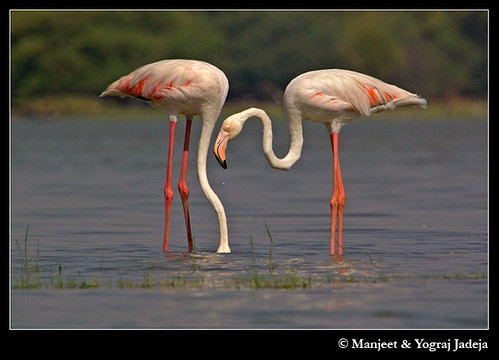
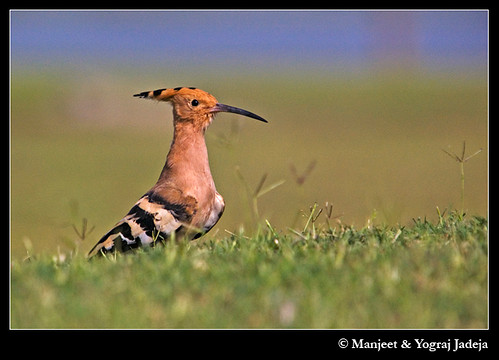
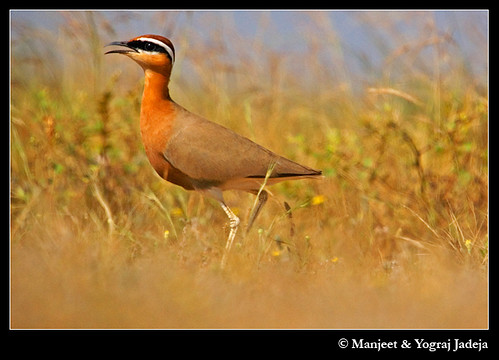

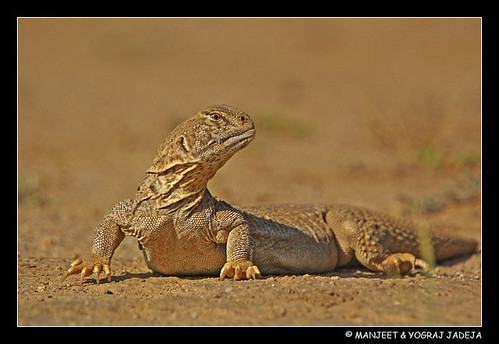
"Glimpses From India's Natural World"
a book about conservation by Shri Akhilesh Sahay who also Authored
"Green Tops in Goa".
We are sure that "Glimpses From India's Natural World" will help to ignite a spark of wonder and awaken a sense of responsibility in the hearts and minds of its readers.
The flamingo image is on the backcover and inside,
while the others are inside.





News,Reviews,Tips,wildlife,nature, photography
book,
publication,
published
Saturday, August 21, 2010
conservation video (moving image slide-show of our images)
News,Reviews,Tips,wildlife,nature, photography
conservation,
video
Thursday, August 19, 2010
A Dose of Diversity - National Wildlife Federation
An interesting article about the Importance of Biodiversity
A Dose of Diversity - National Wildlife Federation
A Dose of Diversity - National Wildlife Federation
Monday, August 16, 2010
Osprey Magic
Had the good fortune to watch the only member of the family Pandionidae (an osprey) with fish fly over our head and land in front of us,and eating it. After a while it was mobbed by a crow and as it took off it was than mobbed by a stilt and than a kite.
It didn't loose its meal to the kite, and was seen feeding on the fish a mile or so from the original feeding perch.
While flying with a fish it keeps the head of the fish forward,
To reduce drag and thereby reducing the effort required to fly.

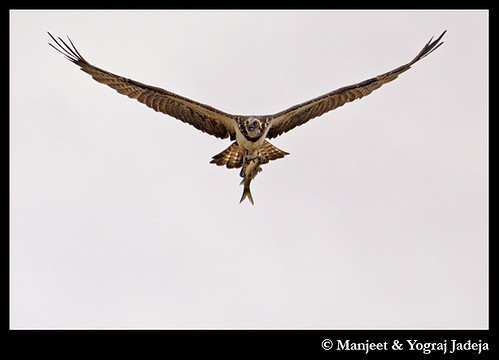


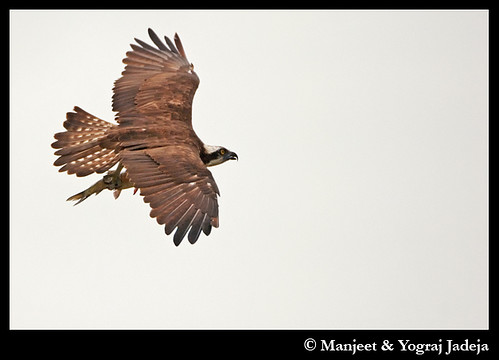
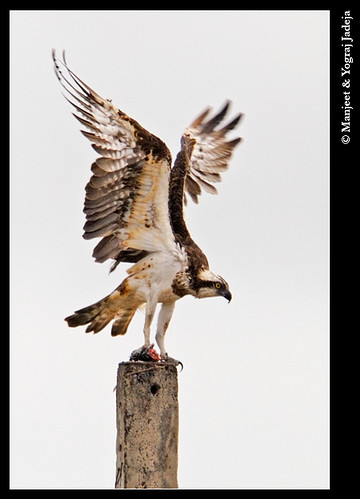
The Osprey and Owls are the only raptors whose outer toe is reversible,
allowing them to grasp their prey with two toes in front and two behind.
This is particularly helpful when they grab and carry slippery fish.

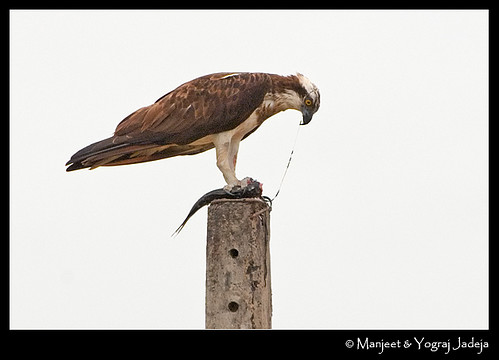
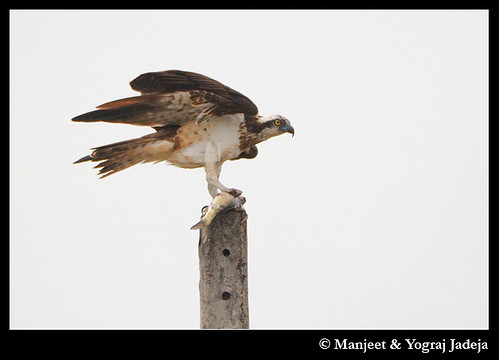
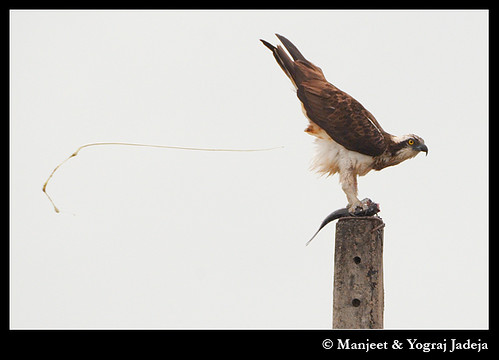
To reduce its weight it usually removes the waste products before taking flight.

It didn't loose its meal to the kite, and was seen feeding on the fish a mile or so from the original feeding perch.
While flying with a fish it keeps the head of the fish forward,
To reduce drag and thereby reducing the effort required to fly.






The Osprey and Owls are the only raptors whose outer toe is reversible,
allowing them to grasp their prey with two toes in front and two behind.
This is particularly helpful when they grab and carry slippery fish.




To reduce its weight it usually removes the waste products before taking flight.

Monday, August 9, 2010
Did you know?
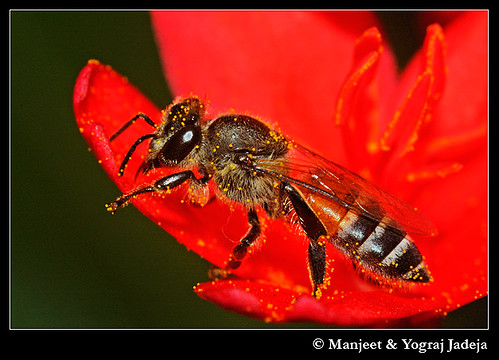
Seemingly unimportant insects are vital for the health of an ecosystem. bees and other insect pollinators provide pollinating services to us "FOR FREE".
Fruits and edible-oil seeds cannot be formed without "HELP" from these critters.
Pollination services provided by insects, mainly bees, are worth EUR 153 billion a year, according to new EU-funded research. This figure is equivalent to almost a tenth of the total value of world agricultural food production. Scientists warn that without these pollination services, the supply of fruits, vegetables and stimulants such as coffee and cocoa would no longer meet the current demand.
News,Reviews,Tips,wildlife,nature, photography
animal,
Did you know?,
fact,
facts,
wildlife
Friday, July 23, 2010
Did you know?
Egyptian vultures (Neophron percnopterus) regularly eat dung, which is a source of Beta-carotene, which gives their beak, the distinctive Yellow color
News,Reviews,Tips,wildlife,nature, photography
animal,
Did you know?,
fact,
facts,
wildlife
Thursday, July 15, 2010
Did you know?
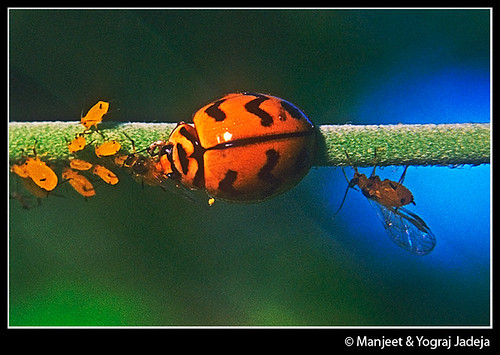
Ladybird eating Aphid
Aphids can reproduce by parthenogenesis and are a pest, once the host plant starts to die out,the females start to grow wings,to fly off in search of another plant to feed on and colonize.Ladybirds feed on aphids and keep their population under control.Even a small insect has a vital role to play in maintaining the health of the ecosystem.Here a Ladybird was feeding on a winged female aphid.
Vivitar V3000s camera,reversal ring,extension tube,vivitar 50mm lens,1/125 sec at
f16,Flash,Kodak Elitechrome 100 film pushed to 200 ISO,scanned with Nikon Coolscan 5000ED
News,Reviews,Tips,wildlife,nature, photography
animal,
Did you know?,
fact,
facts,
wildlife
Thursday, July 8, 2010
HOME (English with subtitles)
We are living in exceptional times. Scientists tell us that we have 10 years to change the way we live, avert the depletion of natural resources and the catastrophic evolution of the Earth's climate.
The stakes are high for us and our children. Everyone should take part in the effort, and HOME has been conceived to take a message of mobilization out to every human being.
For this purpose, HOME needs to be free. A patron, the PPR Group, made this possible. EuropaCorp, the distributor, also pledged not to make any profit because Home is a non-profit film.
HOME has been made for you : share it! And act for the planet.
Yann Arthus-Bertrand
HOME official website
http://www.home-2009.com
PPR is proud to support HOME
http://www.ppr.com
HOME is a carbon offset movie
http://www.actioncarbone.org
More information about the Planet
http://www.goodplanet.info
News,Reviews,Tips,wildlife,nature, photography
conservation,
video
Wednesday, June 16, 2010
Sylvia Earle's TED Prize wish to protect our oceans
Sylvia Earle's TED Prize wish to protect our oceans
News,Reviews,Tips,wildlife,nature, photography
conservation,
video
Monday, June 14, 2010

Crows often mob Raptors and other threats to their nests. here they were attacking a small group of critically endangered white backed vultures.
loved the embarrassed look on the face of the vulture. While the crows are quite adaptable the white backed vulture populations are declining rapidly. These Vultures have suffered a 99 percent population decrease in India and nearby countries since the
early 1990s. The decline has been widely attributed to poisoning by diclofenac, which is used as veterinary non-steroidal anti-inflammatory drug (NSAID),
leaving traces in cattle carcasses which when fed on leads to kidney failure in birds.
News,Reviews,Tips,wildlife,nature, photography
bird,
birds,
endangered,
vultures
Subscribe to:
Posts (Atom)
Search This Blog
Google search
Google search Results
ARKive blog
Photographic tips, equipment reviews and more.......
Photo Rumors
DIY-Photography
Thanks for Visiting our Blog





